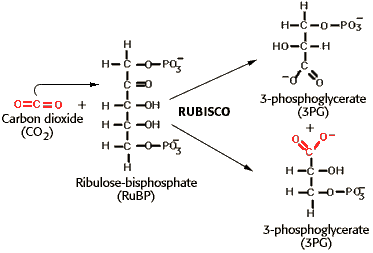 Daily Newsletter
Daily Newsletter
October 10, 2012 Carbon Fixation
Over the last two days, we have discussed how light is used to provide reducing potential (NADPH + H+) and ATP to power the Light-Independent Reactions. What we have discused is Phototrophy, the conversion of light energy into chemical energy (i.e., reducing potential and ATP). Now we turn our attention to how this energy is used: carbon fixation and the production of glucose through the Calvin Cycle.
 The Calvin Cycle is a comples set of reaction that can be broken down into three main stages: Carbon Fixation, Reduction, Regeneration. The diagram to the right is a very minimized cartoon of the Calvin Cycle, provided only to acquait you with the three stages.
The Calvin Cycle is a comples set of reaction that can be broken down into three main stages: Carbon Fixation, Reduction, Regeneration. The diagram to the right is a very minimized cartoon of the Calvin Cycle, provided only to acquait you with the three stages.One of the most important reactions in biology is the carbon fixation step of the Calvin Cycle. This is not hyperbole. This one stage of the Calvin cycle is the major way that CO2 is maid available to living systems. CO2 is a highly oxidized compound, and is considered an inorganic compound. It is also very stable. We have to some how take this compound and add it to an organic structure, thereby making it available to other living systems. This is the critical step in autotrophy.
[NOTE: Some bacteria can use other biochemical pathways for carbon fixation, but the vast majority of carbon fixation will occur in reactions similar to that which occurs in the Calvin Cycle.]
Consider what it means to have bioavilable carbon (i.e., carbon usable by non-autotrophic organisms). Consider what you ate today? Did it consist of starches, vegetables, animals? Did it have protein, carbohydrates, lipids? All of these are organic (biochemical) molecules. They are all made of carbon, and we can consider them derivatives of Carbon Fixation. You may have heard that all of our energy comes from the sun; well the carbon fixation reaction is where we get the carbon to hold that energy.
Above is a great diagram of the carbon fixation step in the Calvin Cycle. CO2 is added to the second carbon (carboxylation). There is an unstable intermediate that is formed, which spontaneously splits into two molecules of 3-Phosphoglycerate (3GP).
Ribulose 1,5 Bisphosphate Carboxylase (RuBisCo) is the enzyme that catalyzes the carbon fixation step. This enzyme is often cited as the most abundant enzyme on the planet, which is most like the case. No one though could doubt that it is the single most important enzyme, for without this, we would not have the quantity of organic carbon that is needed to support life as we know it.
Carbon Cycle
One area of study in ecosystem ecology is the cycling of nutrients through the environment, and one of the most critical cycles is the Carbon Cycle. The diagram below is a simple depiction of the carbon cycle, and
 shows the routes that carbon can go through between biotic (living) and abiotic (non-living) systems. The focus is to look at the CO2 cycle in the diagram. CO2 is incorporated into plants through photosynthesis. Animals eat the plants, extract energy and carbon, and release CO2 (Glycolysis & Citric Acid Cycle). Plants also respire (they have mitochondria), and decay organisms (bacteria and fungi) also respire. This is the most dynamic aspect of the carbon cycle.
shows the routes that carbon can go through between biotic (living) and abiotic (non-living) systems. The focus is to look at the CO2 cycle in the diagram. CO2 is incorporated into plants through photosynthesis. Animals eat the plants, extract energy and carbon, and release CO2 (Glycolysis & Citric Acid Cycle). Plants also respire (they have mitochondria), and decay organisms (bacteria and fungi) also respire. This is the most dynamic aspect of the carbon cycle. Is there other carbon? Yes! There are fossil fuels, limestone deposits, and other geological carbon sinks. But it is the relationship between photosynthesis and respiration that is the strong and dynamic feature of the carbon cycle. The step of Carbon Fixation is the critical reaction.
RuBisCo
Ribulose 1,5 Bisphosphate Carboxylase is a fascinating enzyme, and has been the subject of a great deal of research. As the name implies, the substrate is a five carbon sugar (ribulose) that contains two phosphate, bound to the 1st and 5th carbon respectively. It's action is to add a carboxyl (CO2) group to the ribulose 1,5-bisphosphate.
It is also an enzyme that can carry out the reverse reaction, and can do so quite easily (which is a problem). This is one of the few enzymes where equilibrium becomes important. There is a problem known as photorespiration where RuBisCo reverses, and starts releasing CO2. We will see on Friday that there are evolutionary changes which have prevented this in some plants.
Daily Challenge
In your own words, discuss the connection between this step and the events of glycolysis and the citric acid cycle. Where did decarboxylation take place? Why is RuBisCo and the carbon fixation reaction so critical?Link to Forum

No comments:
Post a Comment